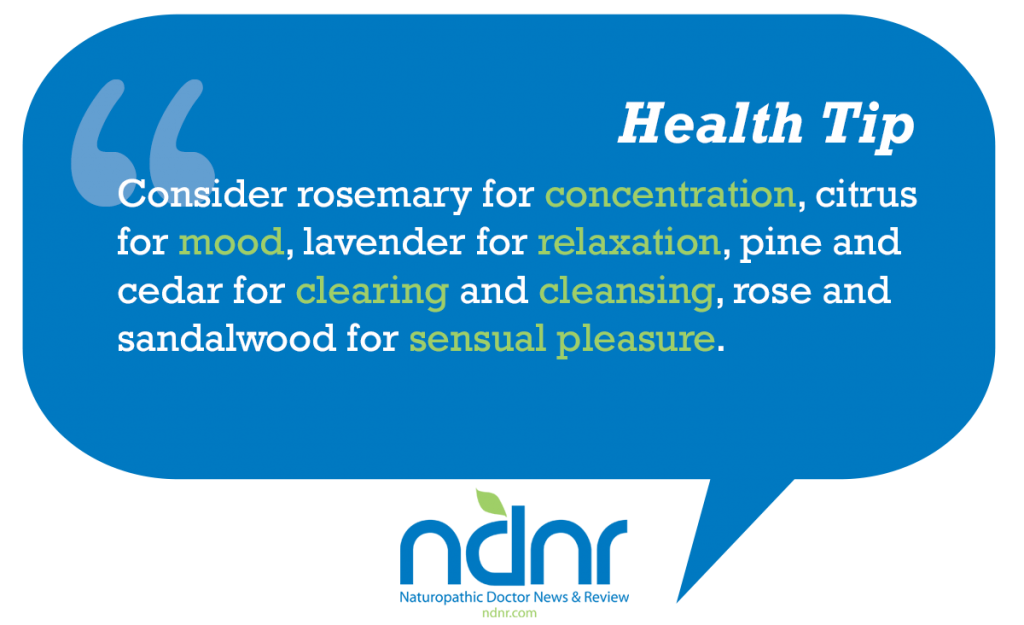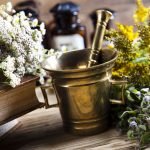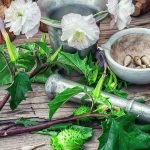Using Plants to Treat the Spirit
Jillian Stansbury, ND
Plants are living beings. Although most of my articles have focused on the plant-based chemistry and research of botanical medicine in terms of diseases, enzyme systems, antioxidant activities, etc., what first got me interested in botanical medicine was a love of nature and the plant realm. I am comforted in the forest; I find joy in looking at flowers; I experience sensual pleasure in the smell of a rose or the aroma of spices; I feel awe over the beauty, the colors and the patterns of plants. If I am stressed, cranky and overwhelmed, I know that working in my garden or going for a walk in the forest will do wonders.
How can this comfort and joy translate into medicine and working with patients? I am most conscious of the fact that when I offer patients Hypericum for their depression or Crataegus for their heart, it is not just hypericin that I am giving to affect their serotonin uptake or procyanidins that affect cardiac muscle fibers. That is the chemical explanation of what imbibing the energy and spirit of that plant can accomplish. Hypericin and procyanidins are actually vibratory energies produced and concentrated by that plant. We can say that hypericin affects serotonin or that procyanidins are inotropic agents, but it would be equally accurate to say that the wisdom and spirit of Hypericum produces a vibration such that when ingested by humans it affects our own vibration … or that Crataegus has love to spare and offers its colorful fruits to help nourish those in need.
These ideas are not just a way of thinking. It is a fact that plants are alive. It is a fact that plants have species-based personalities and chemical profiles. And it is a fact that when ingesting a plant – and I’d say even when viewing, smelling, touching or admiring a plant – humans are affected both biochemically and energetically. To most of you, this is not news. This is a time-honored tradition in both herbal and homeopathic medicine. It is only because of an interest in the last few decades to “prove” the validity of herbal medicine that the dialog has emphasized chemical constituents and their precise physiologic mechanisms of action, as they can be tested with the same methods as pharmaceuticals.
How do we return to our roots to offer not just serotonin reuptake inhibition, but also that joy, that comfort, that beauty that the plant realm offers so freely? Following are a few simple ideas for incorporating plant spirit medicine into your daily practice, even to those who might be skeptical of such concepts.
Medicine With Sensual Appeal
It is our job as physicians to frame our medicine and conversation in a manner that will be received best by any given patient. There are those who need to hear that hypercin is a serotonin reuptake inhibitor. Go ahead and say so. Say what you need to say to help the medicine be best received. There also are subtle ways of offering the spiritual and soulful qualities of the plant realm.
Herbal Teas
Whenever possible, offer medicine that is pleasant and nurturing to the body and has sensual appeal. Pills rarely offer this. Herbal teas come a lot closer, and essential oils and body products are sensually pleasing to almost everyone. When I craft an herbal tea for someone, I always include a handful of rose petals, lavender flowers, ground rose hips, jasmine blossoms and so on to improve the beauty and aroma of the tea and make it more sensually appealing. I also feel that “ritualizing” the tea making and drinking process for anyone that you feel would be receptive to the concept enhances the therapy. For example, teas can be prepared consciously, with affirmations and the awareness that within these dried plant materials are the spirit and wisdom of a living plant: i.e., “… When I ingest this tea, I’m not just imbibing a medicine, I am creating a link between myself and these living beings. I am re-integrating with the natural world from which I have evolved.” If that is too much for you or your patients, simply advise that drinking tea is also an opportunity for self-nurturing. Unlike the one-second act of swallowing a pill, preparation and consumption of tea takes time. Use that time to a healing advantage. Make it be special, relaxing and nourishing to the spirit if at all possible. The art of taking tea is highly developed in Asia. Beautiful little tea houses, silk cushions to sit on, soothing music playing, flowers in a vase on the table, artistic tea pots and cups, a cozy little space to share with a friend … How can this not be enjoyable and soothing to the soul? Encourage patients to create this for themselves. Suggest that they use the time for drinking of tea, even if it is for only 10 minutes, to be a time of repose. Even if it’s at their desk at their office – perhaps they can take off their shoes, light a candle and have a beautiful cup to drink from, at the very least.
Use your intuition and knowledge of your patients to make suggestions of how they might “ritualize” their tea ceremony – a solitary quiet moment? For deep breathing? To write in their journal? To help their children wind down for bed?
Essential Oils
Another way to connect with plants sensually is via essential oils. Essential oils can be used as aromatherapy, put into massage oils and body products, used on the feet for reflexology and so on. Allow patients to help select which aromas please them most, and offer suggestions of how they can use these oils in daily life. For example:
- A drop of a calming essential oil on the dashboard of their car to help with commuter stress
- Several drops on a pot of steaming water in the kitchen to create ambience while they prepare the evening meal after a long day at work
- Several drops on a cotton ball tucked inside their pillowcase for relaxation or romance
- Essential oils in the soap dispenser at the kitchen or bathroom sinks
- Sachets for dresser drawers, or tucked between bed sheets in the linen closet
- A drop on the light bulb of their desk lamp or near their computer to enhance concentration
Consider rosemary for concentration, citrus for mood uplifting, lavender for relaxation, pine and cedar for clearing and cleansing, rose and sandalwood for sensual pleasure and romance.
Herbal Baths
In South America, where I have been studying ethnobotany and healing practices for several years, it is common to use herbal baths for both physical and spiritual health. Of course, it’s the tropics and easy to be naked outside with plants, but even using a bathtub would work in cooler climes. Many metaphysical traditions throughout the world have proposed that use of water on the body cleanses the aura, reestablishes a healthy electromagnetic field and can wick negative energies out of the spirit. When possible, using fresh, self-collected plant material is ideal. In the winter in northern locales, this could be pine or fir branches. In the summer, using whole, fresh flowers to float on the surface of the bath is beautiful and feels exotic and luxurious, and it is not difficult to clean the tub after use. Having patients gather their own materials enhances the effect in that it gets them outside, connecting with plants, touching them, holding them and having a relationship with them.
For people who think that this seems like too much work, something easy and pleasant is to take a few oranges or lemons into the bathroom and, while the tub is filling, cut thin slices, filling the room with wonderful citrus aroma. The slices will float on the top of the water and be easy to clean up when finished, and almost always will uplift the mood for depressed and overwhelmed patients. These baths can be an opportunity to relax, meditate, treat sore muscles by adding epsom salts, treat skin by adding finely ground oat powder, or elicit medicinal and spiritual effects by pouring a pot of brewed tea into the water. Dried plant material could also suffice. Place the herbs in an old pillowcase to serve as a giant tea bag in the bathtub. If in the fall patients must cut back the lavender and rosemary in their garden, or their Melissa and perennials, and have more plant material than they know what to do with, tell them to save it for the bath. Anything aromatic can be simply tied together in bath-sized bundles and stored for use throughout the winter.
Drawing in Patients
In my office dispensary I stock scented aromatherapy candles, smudge sticks, room sprays, incense, tea cups and tea pots, tea strainers and tea bags, typed recipes, essential oils, massage oils and body products. So that I’m not just making vague suggestions, I send people home with something luxuriating and comforting if possible. I try to offer all the tools and supplies, recipes and confidence builders so that people can go home and immediately forge new relationships with plants. Even the most alienated person can relate to a plant spirit if you make it easy and stress-free for them. We see so many people who are stressed with the challenges of modern life, or who have lost direction, purpose, joy and the ability to ground themselves. Addictions creep in when people have no other spiritual anchor; depression when there is no physical, spiritual or sensual pleasure; anxiety when there is no still point on which the soul might settle. Even though it takes only minutes each day to bring soul-nurturing practices into our lives, we often feel we don’t deserve it, shouldn’t take the time when the fridge needs cleaning, or that it takes too much time and trouble, and thus put it off for another day.
This is why concrete “prescriptions” for nurturing the mind and body are every bit as important as medical prescriptions. People who are frenzied, disorganized and overwhelmed might benefit from one crisp, clean corner of their lives where their spirit can be calmed. Start literally with one corner – perhaps their desk, where the calendar is kept up to date, the address book and note pads are handy and where there is no clutter. Make it a “prescription” for patients to maintain this one little corner by attending to it for 5 to 10 minutes per day, and chances are it will act as an anchor to help the mind hold order and from there soothe a frenzied spirit. And there is where the pot of herbal tea goes. These 10 minutes should not be a chore. Bring the pot of nervine tea, light the candle, put on some music, put a flower in a vase or a pinecone on a little tray … and suddenly this is a time to look forward to and a space in which to enjoy spending time.
For people who are numbed, apathetic, lethargic and who feel no pleasure in life, try to help them surround themselves in beauty. If much of their world is traffic, the clatter of office machines, ringing phones, demanding people, fluorescent lights, pollution, chemical smells, etc., at the very least their home should be an oasis of comfort. How can we feel beautiful and inspired if we are surrounded in ugliness and then come home to more work and stress? Maybe the living room or den is the place to start. Relationship issues and turmoil? Start with the bedroom. Self-esteem issues? Patients can clean their clothes closet, sew on missing buttons, polish their shoes, or organize their accessories. Bored with food and not eating well? Have them clean the kitchen cupboards, replenish their culinary spices, go through their recipe books and revive three forgotten favorites, shop for everything needed for a week’s worth of meals, get a new colorful kitchen towel … Suddenly, it’s not so overwhelming to cook dinner.
Tell them to spend an afternoon on their feng shui, and have everything needed for self-nurturing at the ready: massage oils, candles, a dish of rose petals on the bedside table. A mood-lifting room spray, comforting colors and houseplants in the living room for after-work unwinding. Epsom salts, a bowl of oranges, small knife and cutting board, body lotion, comfy towels, robe and slippers in the bathroom. A teapot, a mixture of herbs, their favorite cup and a silver spoon on a tray on the kitchen counter, etc. They can connect with nature by keeping a bird feeder on the porch or backyard tree and enjoy the morning and afternoon feeding hours. Suggest they start a lunar calendar and watch the moon move through its cycles, making it a point to spend five minutes under the full moon each month. Start a simple little pot of culinary herbs outside the kitchen door – some rosemary, chives, parsley, cilantro – and enjoy a minute’s worth of snipping before preparing breakfast or dinner.
If everything is accessible and usable, it is much easier to nurture ourselves. The phrase “plant spirit medicine” need not be uttered, but if you get people to enjoy sprinkling nutmeg on their oatmeal, you actually are interacting with the mentally stimulating spirit of Myristica. If you can inspire a hard-working couple to give each other a nightly foot massage with rose-scented massage oil, you are working with the heart chakra goddess, Rosa. If you dispense a half-pound of dried lavender flowers and teach your sleep-deprived patient to sew little sleep pillows, you are teaming up with that cool tranquil soother, Lavendula.
Get the details on your patients’ lives and stressors, figure out what simple measures are logical starting points, find at least one way to bring nature into their daily lives – and then do this for yourself, as well.
 Jillian Stansbury, ND has practiced in SW Washington for nearly 20 years, specializing in women’s health, mental health and chronic disease. She holds undergraduate degrees in medical illustration and medical assisting, and graduated with honors in both programs. Dr. Stansbury also chairs the botanical medicine program at NCNM and teaches the core botanical curricula, a position she has held for over 18 years. In addition, Dr. Stansbury also writes and serves as a medical editor for numerous professional journals and lay publications, plus teaches natural products chemistry and herbal medicine around the country. At present she is working to set up a humanitarian service organization in Peru and studying South American ethnobotany. She is the mother of two adult children, and her hobbies include art, music, gardening, camping, international travel and studying quantum and metaphysics.
Jillian Stansbury, ND has practiced in SW Washington for nearly 20 years, specializing in women’s health, mental health and chronic disease. She holds undergraduate degrees in medical illustration and medical assisting, and graduated with honors in both programs. Dr. Stansbury also chairs the botanical medicine program at NCNM and teaches the core botanical curricula, a position she has held for over 18 years. In addition, Dr. Stansbury also writes and serves as a medical editor for numerous professional journals and lay publications, plus teaches natural products chemistry and herbal medicine around the country. At present she is working to set up a humanitarian service organization in Peru and studying South American ethnobotany. She is the mother of two adult children, and her hobbies include art, music, gardening, camping, international travel and studying quantum and metaphysics.








